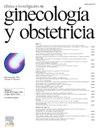Peripartum anxiety symptoms and breastfeeding duration: Prospective observational study
IF 0.1
Q4 OBSTETRICS & GYNECOLOGY
Clinica e Investigacion en Ginecologia y Obstetricia
Pub Date : 2025-04-28
DOI:10.1016/j.gine.2025.101038
引用次数: 0
Abstract
Introduction
There's a lack of effective screening methods to predict early breastfeeding cessation. Our study aimed to assess whether a simple screening of anxiety symptoms after the early postpartum period could help identify those families who discontinue exclusive and mixed breastfeeding early, despite their desire to breastfeed.
Methods
This prospective observational study, conducted at a single center, included women who were admitted to the postpartum ward following vaginal term births. Each participant was accompanied by their companions and babies and expressed a desire to breastfeed. Participants were divided into two groups based on whether they exhibited peripartum anxiety symptoms, assessed using the Hospital Anxiety and Depression scale (HADS). Follow-up assessments of the breastfeeding practices were conducted up to three years postpartum.
Results
A total of 113 eligible women participated in the study, with 92 women successfully followed up for three years. At six months postpartum, 56.5% of the women were exclusively breastfeeding, and 78.3% were still breastfeeding. No significant differences were observed in breastfeeding practices between the group exhibiting peripartum anxiety symptoms and the group without such symptoms.
Conclusion
Our approach, which concentrated on anxiety, did not yield an implementable screening tool for early breastfeeding cessation.
围产期焦虑症状与母乳喂养持续时间:前瞻性观察研究
目前缺乏有效的筛查方法来预测母乳喂养的早期停止。我们的研究旨在评估产后早期焦虑症状的简单筛查是否有助于识别那些早期停止纯母乳喂养和混合母乳喂养的家庭,尽管他们希望母乳喂养。方法:本前瞻性观察性研究在单中心进行,纳入阴道足月分娩后入住产后病房的妇女。每个参与者都有他们的同伴和婴儿陪同,并表达了母乳喂养的愿望。参与者根据是否表现出围产期焦虑症状分为两组,使用医院焦虑和抑郁量表(HADS)进行评估。对母乳喂养做法进行随访评估,直至产后三年。结果共有113名符合条件的女性参与了这项研究,其中92名女性成功随访了三年。产后6个月,56.5%的妇女是纯母乳喂养,78.3%的妇女仍在母乳喂养。在有围生期焦虑症状的组和没有这种症状的组之间,观察到母乳喂养的做法没有显著差异。结论:我们的方法集中在焦虑上,并没有产生一个可实施的早期停止母乳喂养的筛查工具。
本文章由计算机程序翻译,如有差异,请以英文原文为准。
求助全文
约1分钟内获得全文
求助全文
来源期刊

Clinica e Investigacion en Ginecologia y Obstetricia
OBSTETRICS & GYNECOLOGY-
CiteScore
0.20
自引率
0.00%
发文量
54
期刊介绍:
Una excelente publicación para mantenerse al día en los temas de máximo interés de la ginecología de vanguardia. Resulta idónea tanto para el especialista en ginecología, como en obstetricia o en pediatría, y está presente en los más prestigiosos índices de referencia en medicina.
 求助内容:
求助内容: 应助结果提醒方式:
应助结果提醒方式:


